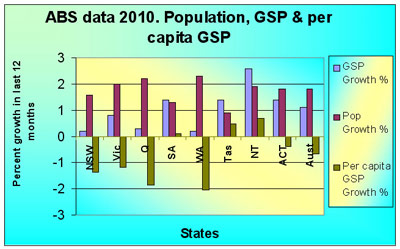The ABS released its latest figures for population growth in the Australian states and territories just a few days ago. These figures showed that those states with the highest rates of population growth performed worst in terms of per capita economic growth.
If, for the moment, economic growth is assumed to be a measure of “standard of living” then the states with the highest rates of population growth, Western Australia and Queensland suffered the largest reduction in the standard of living, -2 per cent and -1.9 per cent respectively.
On the other hand the Northern Territory, Tasmania and South Australia showed growth of per capita GSP of 0.7, 0.5 and 0.1 per cent respectively. Australia, as a whole suffered a decline in per capita GDP of 0.7 per cent. (see graph)
Advertisement

So much for the repeated claim by Wayne Swan that the Australian economy is performing well! These figures clearly indicate that far from improving the lot of ordinary citizens, population growth by exceeding economic growth is, on average, making each citizen worse off.
Importantly also, these raw figures do not reveal the full extent of the damaging impact of population growth on the welfare of ordinary citizens. Much of the “cost” of the additional infrastructure required for population growth is added to and inflates GDP and GSP. Thus in terms of the existing population the growth of total GDP/GSP does not represent a real benefit.
Moreover, the costs borne by ordinary citizens in terms of traffic congestion, longer travel times and ameliorating environmental damage are also added to GDP/GSP. These are real costs masquerading as benefits through the misleading way in which GDP and GSP measures are constructed.
These data expose, yet again, the deceit behind the self-interested claims of property developers and some other business interests that population growth is good for Australians and the similar claims made by the major parties that receive large donations from these interests.
Throughout this short article the conventional economic view has been adopted so far: that seeking to grow the economy (grow GDP or GSP) is a desirable social goal and that this growth is a useful surrogate measure of improving human welfare. This is not the case and for reasons which go well beyond the inclusion of costs as benefits mentioned above.
Advertisement
It is claimed that Australia needs more people because our economy is substantially dependent of mineral exploitation and we need skilled workers in those industries and other skilled workers to support the first lot, i.e., build houses for them. The exploitation of non-renewable mineral resources adds to GDP rather like taking money from your bank account “adds to your wealth”. When non-renewable resources are taken from the ground our capital assets are depleted just as our bank account is depleted when we withdraw money. GDP is a cash-flow account rather like money in our pocket. Because we keep no National Capital Account, synonymous with our personal bank account, we are led to believe we are becoming richer through mineral exploitation whereas comprehensive national accounts would show we only become richer to the extent of the value-adding that we do to these resources - and that is very little.
And how does this fit with population? Through non-renewable mineral exploitation, Australia is living on capital, not on interest on capital. We are running down our capital quite quickly. For example according to ABARE, Australia’s black coal reserves amount to 39 billion tonnes and our rate of increase in exploitation is 2.3 per cent per annum. At that rate the reserves will all be gone just after 2050 when, on current rates of population growth, our population will be of the order of 40 million.The implicit assumption that Australia can continue to grow both its GDP (based on mineral exploitation) and its population is putting us on a collision course for collapse.
Discuss in our Forums
See what other readers are saying about this article!
Click here to read & post comments.
37 posts so far.